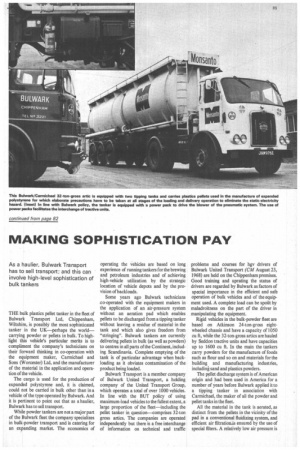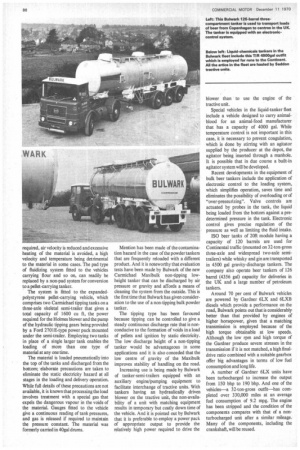MAKING SOPHISTICATION PAY
Page 91

Page 92

If you've noticed an error in this article please click here to report it so we can fix it.
As a haulier, Bulwark Transport has to sell transport: and this can involve high-level sophistication of bulk tankers THE bulk plastics pellet tanker in the fleet of Bulwark Transport Ltd, Chippenham, Wiltshire, is possibly the most sophisticated tanker in the UK—perhaps the world— carrying powder or pellets in bulk. To highlight this vehicle's particular merits is to compliment the company's technicians on their forward thinking in co-operation with the equipment maker. Carmichael and Sons (Worcester) Ltd, and the manufacturer of the material in the application and operation of the vehicle.
The cargo is used for the production of expanded polystyrene and, it is claimed, could not be carried in bulk other than in a vehicle of the type operated by Bulwark. And it is pertinent to point out that as a haulier, Bulwark has to sell transport.
While powder tankers are not a major part of the Bulwark fleet the company specializes in bulk-powder transport and is catering for an expanding market. The economics of operating the vehicles are based on long experience of running tankers for the brewing and petroleum industries and of achieving high-vehicle utilization by the strategic location of vehicle depots and by the provision of backloads.
Some years ago Bulwark technicians co-operated with the equipment makers in the application of an air-pressure system without an aeration pad which enables pellets to be discharged from a tipping tanker without leaving a residue of material in the tank and which also gives freedom from "stringing". Bulwark tankers are currently delivering pellets in bulk (as well as powders) to centres in all parts of the Continent, including Scandinavia. Complete emptying of the tank is of particular advantage when backloading as it obviates contamination of the product being loaded.
Bulwark Transport is a member company of Bulwark United Transport, a holding company of the United Transport Group, which operates a total of over 1000 vehicles. In line with the BUT policy of using maximum-load vehicles to the fullest extent, a large proportion of the fleet—including the pellet tanker in question—comprises 32-ton gross artics. The companies are operated independently but there is a free interchange of information on technical and traffic problems and courses for hgv drivers of Bulwark United Transport (CM August 23, 1968) are held on the Chippenham premises. Good training and uprating the status of drivers are regarded by Bulwark as factors of special importance in the efficient and safe operation of bulk vehicles and of the equipment used. A complete load can be spoilt by maladroitness on the part of the driver in manipulating the equipment.
Rigid vehicles in the bulk-powder fleet are based on Atkinson 24-ton-gross eightwheeled chassis and have a capacity of 1050 cu ft, while the 32-ton-gross artics are hauled by Seddon tractive units and have capacities up to 1600 cu ft. In the main the tankers carry powders for the manufacture of foods such as flour and so on and materials for the building and manufacturing industries, including sand and plastics powders.
The pellet discharge system is of American origin and had been used in America for a number of years before Bulwark applied it to a tipping tanker in association with Carmichael, the maker of all the powder and pellet tanks in the fleet.
All the material in the tank is aerated, as distinct from the pellets in the vicinity of the pad in a conventional fluidizing system, and efficient air filtration.is ensured by the use of special filters. A relatively low air pressure is required, air velocity is reduced and excessive heating of the material is avoided, a high velocity and temperature being detrimental to the material in some cases. The pad type of fluidizing system fitted to the vehicles carrying flour and so on, can readily be replaced by a non-pad system for conversion to a pellet-carrying tanker.
The system is fitted to the expandedpolystyrene pellet-carrying vehicle, which comprises two Carmichael tipping tanks on a three-axle skeletal semi-trailer that gives a total capacity of 1600 cu ft, the power required for the Holmes blower and the pump of the hydraulic tipping gears being provided by a Ford 2701E-type power pack mounted under the semi-trailer. Employing two tanks in place of a single larger tank enables the loading of more than one type of material at any onetime.
The material is loaded pneumatically into the top of the tanks and discharged from the bottom; elaborate precautions are taken to eliminate the static electricity hazard at all stages in the loading and delivery operation. While full details of these precautions are not available, it is known that processing the load involves treatment with a special gas that expels the dangerous vapour in the voids of the material. Gauges fitted to the vehicle give a continuous reading of tank pressures, and gas is released if required to maintain the pressure constant. The material was formerly carried in 40gal drums. Mention has been made of the contamination hazard in the case of the powder tankers that are frequently reloaded with a different product. And it is noteworthy that evaluation tests have been made by Bulwark of the new Carmichael Maxibulk non-tipping lowheight tanker that can be discharged by air pressure or gravity and affords a means of cleaning the system from the outside. This is the first time that Bulwark has given consideration to the use of a non-tipping bulk powder tanker.
The tipping type has been favoured because tipping can be controlled to give a steady continuous discharge rate that is nonconducive to the formation of voids in a load of pellets and ignition by static electricity. The low discharge height of a non-tipping tanker would be advantageous in some applications and it is also conceded that the low centre of gravity of the Maxibulk improves stability of handling on the road.
Increasing use is being made by Bulwark of tanker-semi-trailers equipped with an auxiliary engine/pumping equipment to facilitate interchange of tractive units. With tankers having an hydraulically driven blower on the tractive unit, the non-availability of a unit with matching equipment results in temporary but costly down time of the vehicle. And it is pointed out by Bulwark that it is preferable to employ a power pack of appropriate output to provide the relatively high power required to drive the blower than to use the engine of the tractive unit.
Special vehicles in the liquid-tanker fleet include a vehicle designed to carry animalblood for an animal-food manufacturer that has a capacity of 4000 gal. While temperature control is not important in this case, it is necessary to prevent coagulation, which is done by stirring with an agitator supplied by the producer at the depot, the agitator being inserted through a manhole. It is possible that in due course a built-in agitator system will be developed.
Recent developments in the equipment of bulk beer tankers include the application of electronic control to the loading system, which simplifies operation, saves time and eliminates the possibility of overloading or of "over-pressurizing". Valve controls are actuated by probes in the tank, the liquid being loaded from the bottom against a predetermined pressure in the tank. Electronic control gives precise regulation of the pressure as well as limiting the fluid intake.
ISO beer tanks of 20ft module having a capacity of 120 barrels are used for Continental traffic (mounted on 32-ton-gross three-axle and widespread two-axle semitrailers) while whisky and gin are transported in 4500 gal gravity-discharge tankers. The company also operate beer tankers of 126 barrel (4356 gal) capacity for deliveries in the UK and a large number of petroleum tankers.
Around 70 per cent of Bulwark vehicles are powered by Gardner 6LX and 6LXB diesels which provide a performance on the road, Bulwark points out that is considerably better than that provided by engines of higher horsepower, given that a matching transmission is employed because of the high torque obtainable at low speeds. Although the low rpm and high torque of the Gardner produce severe stresses in the transmission if it is not matched, a high finaldrive ratio combined with a suitable gearbox offer big advantages in terms of low fuel consumption and long life.
A number of Gardner 6LX units have been turbocharged to increase the output from 150 bhp to 190 bhp. And one of the vehicles—a 32-ton-gross outfit—has completed over 330,000 miles at an average fuel consumption of 9.2 mpg. The engine has been stripped and the condition of the components compares with that of a nonturbocharged unit after a similar mileage. Many of the components, including the crankshaft, will be reused.






























































































































































